Relationship between diagonal earlobe creases and coronary artery disease as determined via angiography
- PMID: 26868940
- PMCID: PMC4762085
- DOI: 10.1136/bmjopen-2015-008558
Relationship between diagonal earlobe creases and coronary artery disease as determined via angiography
Abstract
Objective: This study was designed to examine the prevalence of unilateral and bilateral diagonal earlobe creases (DELCs) with respect to the diagnosis of coronary heart disease (CHD).
Methods: A total of 558 consecutive participants (402 males and 156 females) aged 36-91 years who underwent coronary angiography were enrolled in this study. The participants were classified as being without a DELC, having a unilateral DELC and having bilateral DELCs; participants with either a unilateral DELC or bilateral DELCs were defined as participants with DELCs. Significant CHD was defined as at least one major vessel with >50% stenosis, and coronary atherosclerosis severity was defined using the Gensini scoring system.
Results: In the present study, bilateral DELCs were more frequently among male (p=0.001), CHD (p=0.000), older people (p=0.000) and those with more severe coronary artery atherosclerosis (p=0.000). The results of the multiple regression analyses indicated that DELCs (OR, 4.861; 95% CI 3.093 to 7.642, p=0.000) remained independently associated with a risk of CHD. It was assumed that participants without a DELC have a certain background risk for CHD (OR is assumed to be 1); the results of the multivariate logistic regression indicated that the relative risk of CHD among participants with bilateral DELCs was 5.690 among all participants (OR, 5.690; 95% CI 3.450 to 9.384, p=0.000), 5.436 among male participants (OR, 5.436; 95% CI 2.808 to 10.523, p=0.000) and 7.148 among female participants (OR, 7.148; 95% CI 3.184 to 16.049, p=0.000). Moreover, a positive association between DELC and age (SI=1.21, SIM=1.65, AP =0.132), gender (SI=2.09, SIM=0.81, AP=0.49) and smoking status (SI=1.49, SIM=0.73, AP=0.29) was found, respectively.
Conclusions: The results of the present study indicated that DELCs are a simple and a feasible means of identifying CHD. However, the exact mechanism underlying the relationship between DELCs and CHD warrants further study.
Keywords: CARDIOLOGY.
Published by the BMJ Publishing Group Limited. For permission to use (where not already granted under a licence) please go to http://www.bmj.com/company/products-services/rights-and-licensing/
Figures

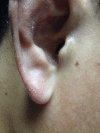
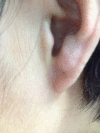
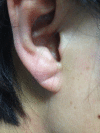
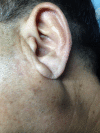
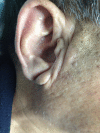

Similar articles
-
The relationship of diagonal earlobe crease (Frank's sign) and obstructive coronary artery disease in patients undergoing coronary angiography.Wien Klin Wochenschr. 2023 Dec;135(23-24):667-673. doi: 10.1007/s00508-023-02297-y. Epub 2023 Oct 30. Wien Klin Wochenschr. 2023. PMID: 37902857
-
Diagonal earlobe crease and coronary artery disease in a Chinese population.BMC Cardiovasc Disord. 2014 Apr 4;14:43. doi: 10.1186/1471-2261-14-43. BMC Cardiovasc Disord. 2014. PMID: 24708687 Free PMC article.
-
Relation of diagonal ear lobe crease to the presence, extent, and severity of coronary artery disease determined by coronary computed tomography angiography.Am J Cardiol. 2012 May 1;109(9):1283-7. doi: 10.1016/j.amjcard.2011.12.024. Epub 2012 Feb 13. Am J Cardiol. 2012. PMID: 22335855
-
[The diagonal ear lobe crease for evaluating coronary risk].Z Kardiol. 1995 Jul;84(7):512-9. Z Kardiol. 1995. PMID: 7676721 Review. German.
-
Why we should be looking for earlobe creases in ENT. A systematic review and meta-analysis of diagonal earlobe crease and coronary artery disease.J Laryngol Otol. 2025 Mar;139(3):160-167. doi: 10.1017/S0022215121004138. J Laryngol Otol. 2025. PMID: 34924071
Cited by
-
The relationship of diagonal earlobe crease (Frank's sign) and obstructive coronary artery disease in patients undergoing coronary angiography.Wien Klin Wochenschr. 2023 Dec;135(23-24):667-673. doi: 10.1007/s00508-023-02297-y. Epub 2023 Oct 30. Wien Klin Wochenschr. 2023. PMID: 37902857
-
A Myth Still Needs to be Clarified: A Case Report of the Frank's Sign.Cureus. 2018 Jan 17;10(1):e2080. doi: 10.7759/cureus.2080. Cureus. 2018. PMID: 29560293 Free PMC article.
-
Adropin and Irisin Deficiencies Are Associated With Presence of Diagonal Earlobe Crease in CAD Patients.Front Cardiovasc Med. 2021 Oct 12;8:719763. doi: 10.3389/fcvm.2021.719763. eCollection 2021. Front Cardiovasc Med. 2021. PMID: 34712706 Free PMC article.
-
The prognostic value of deep earlobe creases in patients with acute ischemic stroke.Front Cardiovasc Med. 2023 May 30;10:1096044. doi: 10.3389/fcvm.2023.1096044. eCollection 2023. Front Cardiovasc Med. 2023. PMID: 37324621 Free PMC article.
-
Advancements in Frank's sign Identification using deep learning on 3D brain MRI.Sci Rep. 2025 Jan 18;15(1):2383. doi: 10.1038/s41598-024-82756-2. Sci Rep. 2025. PMID: 39827273 Free PMC article.
References
-
- Yin Huihe. The basic theory of Chinese traditional medicine. 2nd edn Beijing: People's Medical Publishing House Co.,Ltd (PMPH), 1985:9.
-
- Frank ST. Aural sign of coronary-artery disease. N Engl J Med 1973;289:327–8. - PubMed
Publication types
MeSH terms
LinkOut - more resources
Full Text Sources
Other Literature Sources
Medical
